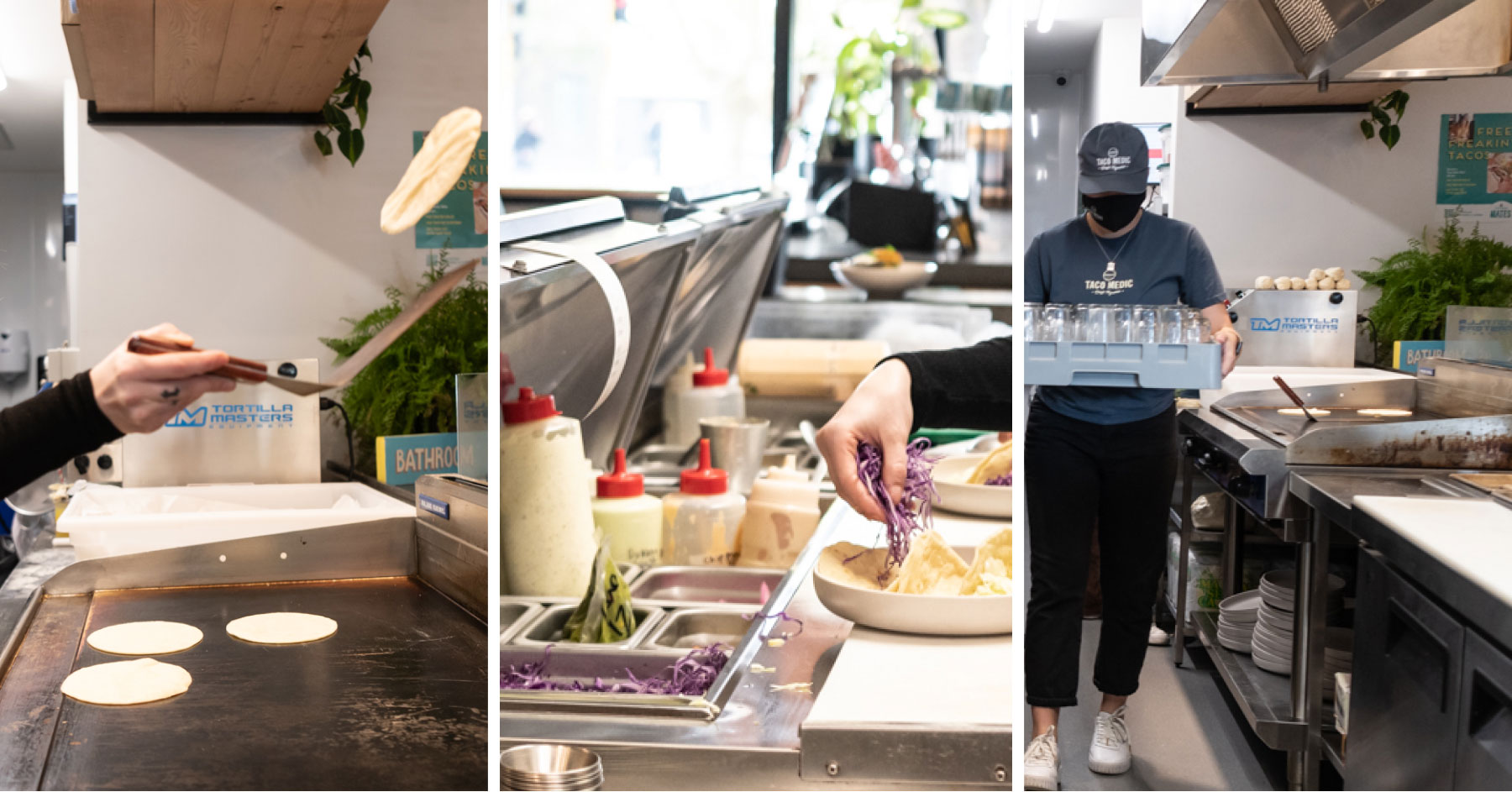
Your kitchen is the heart of your restaurant, and the dishes that come out of it (and how quickly they’re prepared) can make or break the dining experience for customers.
A commercial kitchen’s layout can determine how smoothly your restaurant functions. When the kitchen is designed strategically, the back-of-house (BOH) team can work efficiently and produce high-quality meals consistently.
However, when the kitchen is put together haphazardly, it can become an obstacle for the BOH team. In a poorly designed kitchen, staff can’t be as efficient because they are hindered by cramped spaces and disruptive workflows.
A successful commercial kitchen layout is easy to use, meets the restaurant’s needs and enables your service staff to deliver an amazing restaurant experience. Whether you’re building a restaurant from scratch or have hit a wall with your current design and need to renovate, this guide will empower you to identify the best and most efficient layout for your kitchen.
Let’s dive in!
- The 6 key components of a commercial kitchen layout plan
- The most important commercial kitchen layout considerations
- The six types of commercial kitchen layouts
- How to choose the right commercial kitchen layout for your restaurant
Opening a Restaurant: 13-Step Master Checklist
Download our free Opening a Restaurant Master Checklist covering the A to Z of opening a new restaurant.
6 key components of a commercial kitchen layout plan
Before designing a commercial kitchen space, it’s crucial to understand exactly what your kitchen needs to achieve and the equipment associated with those needs. When you know what components need to fit into the space from the beginning of the design process, you will be able to design your commercial kitchen layout more effectively.
Firstly, you’ll need to ask yourself some key questions to understand which components and (how many) you’ll need for your kitchen.
- How much space do I have available?
- What is my style of service?
- What type of dishes will be prepared?
- Does my menu need lots of preparation?
- How will dishes be prepared?
- How will dishes be cooked?
- Do I have additional store rooms?
- Will everything need to be stored in the kitchen?
- Will I have more fresh produce or dried/tinned goods?
Once you’ve answered these questions, you’ll have a decent idea of what components you’ll need to operate your kitchen. And, while every kitchen is different, we’ve compiled a list of the 6 most common commercial kitchen components.
The 6 components of a commercial kitchen
- Delivery
- Storage
- Washing station
- Food preparation
- Cooking station
- Service area
1. Delivery
Every restaurant kitchen needs a dedicated space to receive deliveries. While your delivery parking and access door might not directly lead to your kitchen or storage rooms, it should be conveniently located near your kitchen to reduce spoilage or wastage during offloading.
2. Storage
Your restaurant’s kitchen will store a variety of items, including cooking tools (utensils, pans, etc.), food (produce, meats, dry goods), and place settings (glasses, plates, linens).
Your kitchen will need separate storage units for each of these needs, such as a refrigerator for perishable foods, a pantry for dry goods, and cupboards for place settings and tools.
3. Washing station
A lot of cleaning goes on in a commercial kitchen to ensure the safety of the food being served and the cleanliness of the dishes on which the food is served. We recommend creating separate washing stations for food and dishes, so that dirty dish suds never land on clean produce.
To run smoothly, your washing stations will need commercial dishwashing machines, sinks, and drying racks.
4. Food preparation
A commercial kitchen may have several food preparation areas depending on what kind of food is on the menu. The food prep section of a restaurant’s kitchen consists of counter space, cutting tools, and storage containers.
Place food preparation zones near a refrigerator so your BOH team can quickly and safely store raw ingredients until they’re ready to use.
Your layout and equipment should also account for customers with food allergies. To reduce the risk of cross-contamination, kitchen staff must ensure food is stored correctly and away from cooking stations, makes sure food products and ingredients are clearly labelled and prepare allergen-free meals separately, using a dedicated area and equipment.
5. Cooking station
Unless your restaurant’s concept is raw foods, your kitchen will need a lot of cooking equipment to execute your menu. Most restaurants have gas range-oven combinations and commercial fryers, and some specialised cooking appliances. A kitchen display system makes it easy for BOH staff to keep up with incoming tickets.
6. Service
A commercial kitchen’s service area is used for plating dishes and handing them off to servers to deliver to diners. A service area should have heat lamps to keep food warm.
Place your kitchen’s service area as close to the dining room as possible to lessen the distance from the kitchen to the table for waiters.
Now that you understand the components of a functional commercial kitchen, and have thought about elements such as safety and ergonomics, it’s time to start designing your restaurant’s kitchen. Take inspiration from these five popular commercial kitchen layouts.
The most important commercial kitchen layout considerations
Now that you understand the key components of a commercial kitchen, you must also factor a few crucial considerations into your kitchen’s design to ensure that it’s safe and functional.
Ergonomics
Ergonomics is the science behind “designing and arranging things people use so that the people and things interact most efficiently and safely,” according to the Merriam-Webster Dictionary.
To create a functional, user-friendly commercial kitchen layout, you must consider how much equipment the kitchen will need to hold, how many people will be in the kitchen and the flow of the staff’s routes between stations.
Space
How much room you have to work with will limit which commercial kitchen layouts you can adopt. Industry guidelines recommend dedicating 60% of your commercial space to the front of house (FOH) and reserving the remaining 40% for your back of house (BOH).
For example, if your restaurant has an area of 50 square metres, 30 square metres would be used for the dining area and the remaining 20 square metres would be for the kitchen.
Staff communication
Don’t forget about the human elements of designing a space. Facilitate staff interaction and communication with an open floor plan instead of a maze-like kitchen with walled-off sections. Make it easy for executive chefs and managers to oversee what’s happening in the kitchen so that they can train and communicate with staff easily.
This consideration may be more important in a fast-food environment with inexperienced staff than at a high-end restaurant with experienced chefs.
Safety
Safety and design go hand in hand. First, you need to consider food safety in your restaurant. Design a space that keeps food safe for consumption. A few simple ways to do this include placing your receiving near the fridge and avoiding cleaning chemicals near food.
You’ll also need to checkgovernment regulations to ensure that your restaurant takes food safety precautions that go beyond common sense. Local regulations may determine your commercial kitchen’s layout or design elements in some states.
You should also consider your staff’s health as you design your commercial kitchen. Build proper ventilation into the space and place mats on the ground to reduce knee and back wear and tear from prolonged standing.
Fire safety is another major element you must take into consideration while designing a safe restaurant kitchen. Ensure fire exits are easily accessible, clearly signed and never obstructed. Install smoke detectors and fire extinguishers. Work with your interior designer to make room for everyday kitchen equipment in your space and emergency tools.
6 Types of commercial kitchen layouts
Now that we’ve outlined the components of a functional commercial kitchen and have thought about elements such as safety and ergonomics, it’s time to start designing your restaurant’s kitchen.
Take inspiration from these six popular commercial kitchen layouts.
Commercial kitchen layout types
- Assembly line layout
- Island layout
- Zone-style layout
- Galley layout
- Open kitchen layout
- Ergonomic layout
1. Assembly line layout
The assembly line configuration consists of a central row or island that starts with food prep and ends with a completed item ready to be taken to be served.
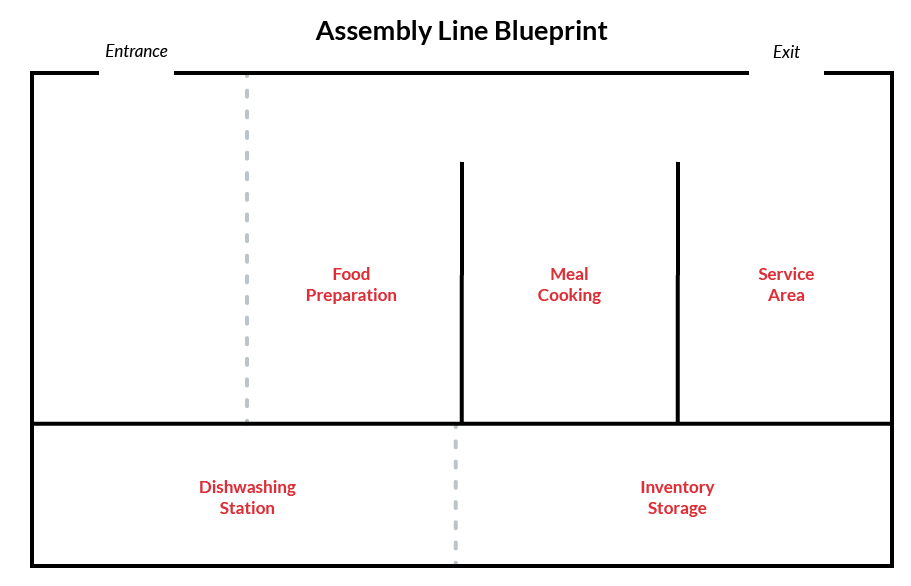
The benefits of the assembly line layout
This commercial kitchen layout facilitates the production of lots of the same type of dish over and over again. The assembly line works best with multiple cooks responsible for one part of the food production process.
Which restaurant types are best for the assembly line layout?
The assembly line layout is best for fast food restaurants or restaurants with limited menus that have similar preparation styles, like pizza or build-your-own dish restaurants.
Fast-casual chains likeSubway andZambrero use an assembly line configuration in the customer-facing side of their kitchens.
2. Island layout
The island commercial kitchen layout starts with the ring layout and adds a central preparation or cooking station. For example, a kitchen may have storage units, washing stations, food prep counters along its perimeter, and cooking equipment in its centre.
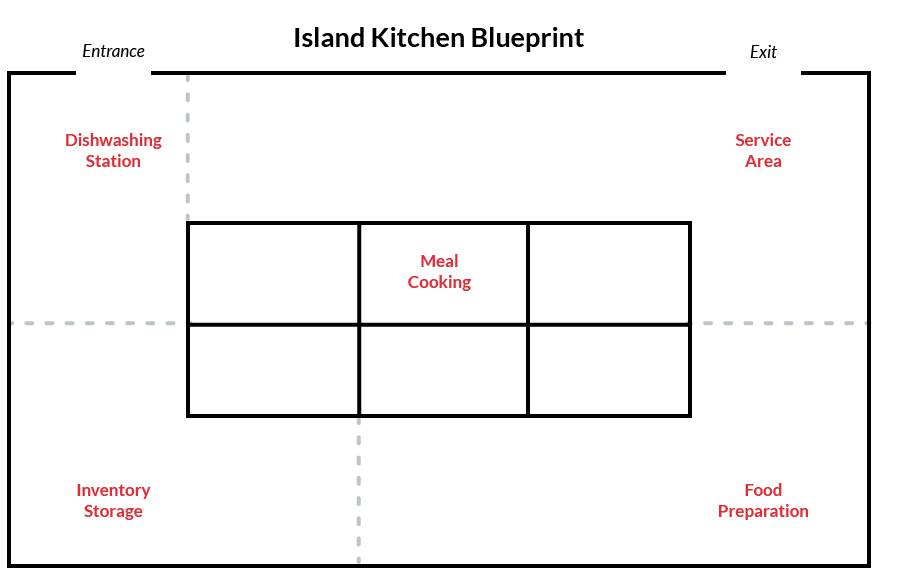
The benefits of the island kitchen layout
With a central “command centre” or passthrough point for all meals, the island configuration facilitates staff communication and executive chef supervision.
Which restaurant types are best for the island kitchen layout?
The island setup is best for restaurants with ample kitchen space to ensure that the island doesn’t create an obstacle for the BOH team.
You can watch the island layout in action at the Dutch restaurantLatour.
3. Zone-style layout
The zone-style layout creates separate zones, or stations, for each type of activity in the kitchen or for each kind of dish that is prepared. For example, a restaurant could have a soup and salad station, meat station, frying station, and baking station.
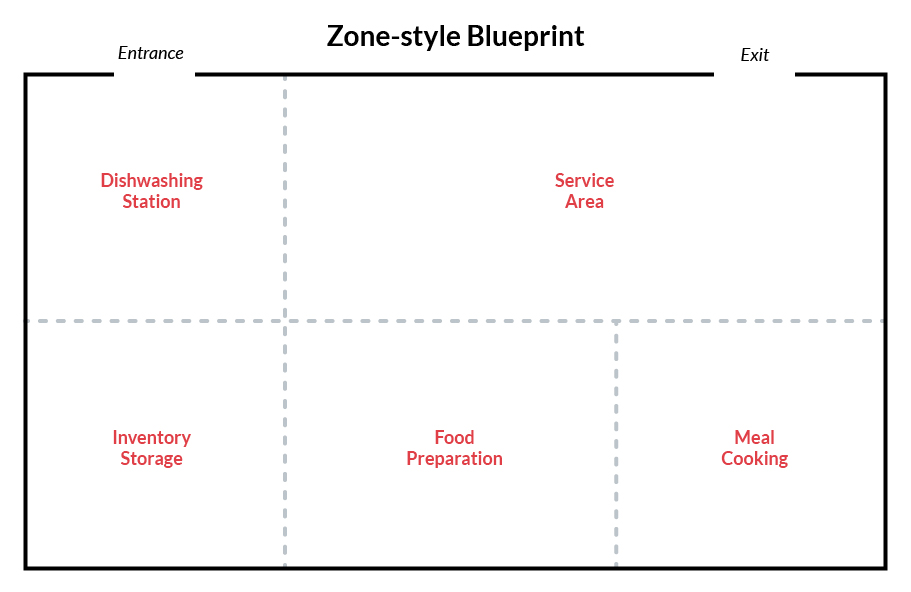
The benefits of the zone-style layout
The zone-style commercial kitchen layout keeps the kitchen organised and allows different types of dishes to be prepared simultaneously. This layout helps BOH staff divide and conquer. You can hire a specialised chef for each station rather than a line cook to create everything from start to finish.
Which restaurant types are best for the zone-style kitchen layout?
This layout is best for restaurants with diverse menus and lots of staff. The zone-style layout is suited for large operations like hotel restaurants, catering kitchens, or event space kitchens.
Restaurants with small kitchens should avoid station-based configuration as it doesn’t allow for multitasking. You’ll need ample space and staff to make this type of kitchen function smoothly.
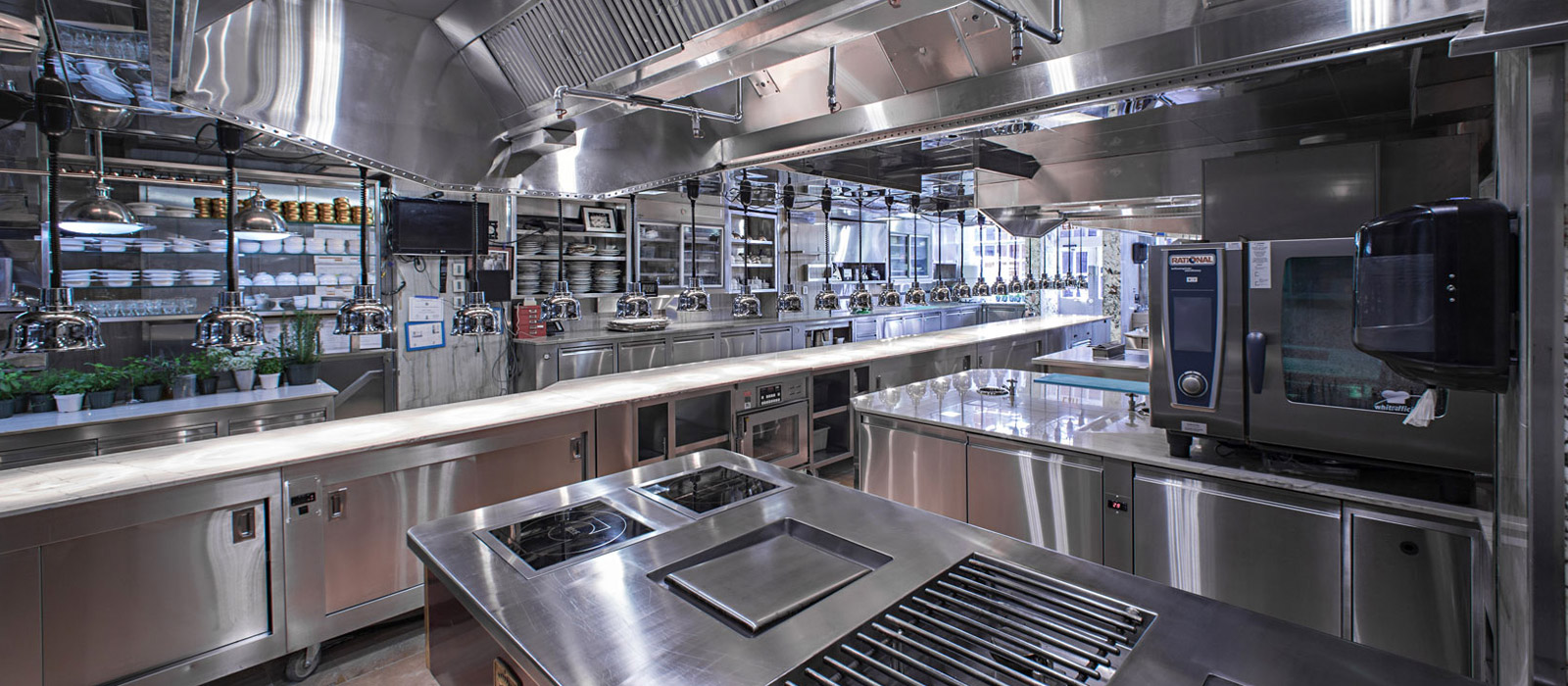
4. Galley layout
In this commercial kitchen layout, all stations and equipment are on the kitchen’s perimeter. In a very tight space, kitchen equipment is placed along parallel walls.
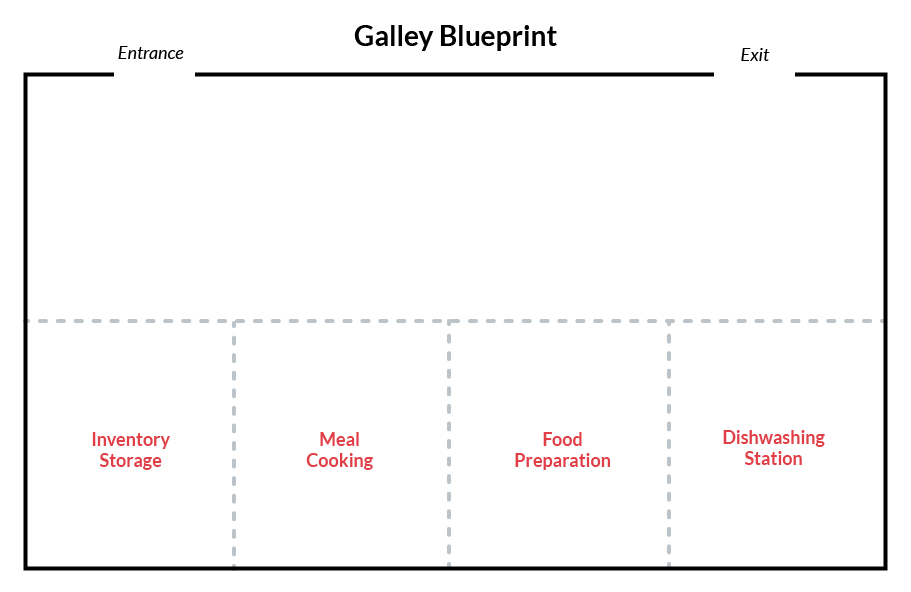
The benefits of the galley layout
If your kitchen is large enough to have a ring layout with space in the centre, you can have multiple cooks in the kitchen, who can easily rotate to work across multiple stations. In a very small space, like a food truck, the galley kitchen is the only option the space allows.
Which restaurant types are best for the galley kitchen layout?
The ring and galley configurations are best for tight spaces with few staff, such as food trucks.
5. Open kitchen layout
An open kitchen layout lets customers see the action that usually takes place behind the scenes. Any commercial kitchen layout can be turned into an open kitchen by removing a wall.
With an open kitchen layout, it’s best to keep hot cooking appliances as far away from customers as possible. A glass partition between the service area and guest seating is a smart choice to protect the food from unexpected sneezes or coughs.
The benefits of the open kitchen layout
The open kitchen is great for entertaining guests. An open kitchen is also an excellent opportunity to maximise a small space.
Which restaurant types are best for the open kitchen layout?
Open layout kitchens are typically seen at high-end restaurants or restaurants with small commercial spaces. Watching the cooks prepare dishes becomes an integral part of the dining experience.
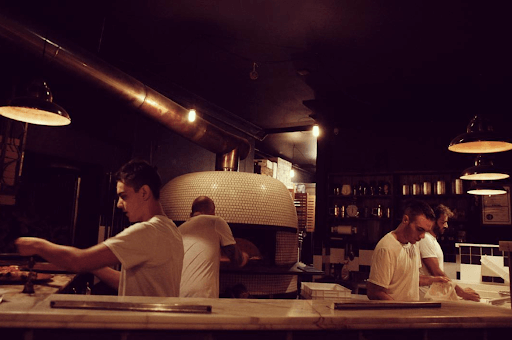
How to choose the right commercial kitchen layout for your restaurant
No one kitchen layout is better than another and the best layout for your restaurant will depend on the space, the complexities of your menu and how to ensure a functional and safe workspace. The right commercial kitchen layout will enable your BOH team to do their best work safely and efficiently, resulting in lower staff turnover and higher customer satisfaction.
Victor Cardamone, owner of restaurant kitchen design firmMise Designs, says that your ideal kitchen layout depends entirely on your kitchen space’s size and shape.
“If your restaurant space has a long, narrow kitchen space, then an assembly line layout will be most effective, whereas if the kitchen space was a square room, an island layout would be more appropriate. Context is everything.”
You should never force a kitchen layout type into a space that wasn’t designed for it.
With that in mind, Cardamone suggests following these steps when evaluating a commercial space’s ideal kitchen layout:
- Create a process to execute each menu item
- Develop an equipment list for each kitchen station based on menu requirements
- Organise or design the equipment layout for each station
- Arrange the stations next to each other that share menu components
- Determine your service process to complete dishes for delivery to the customer
- Design your expediting station and place it at the centre point of all culinary stations
- Understand your building limitations and be willing to find alternate execution and service delivery methods to accommodate
- Visualise a dry run, executing each menu item in your new kitchen to ensure they are created and delivered efficiently
When you’re looking for the ideal commercial space for your restaurant, you need to actively assess the space’s potential. Which type of commercial kitchen layout works best for your service type and the kitchen space? If you’re having issues pinpointing which of the five kitchen layouts will work best, consider hiring professionals to help you out.
Good luck!
Opening a Restaurant: 13-Step Master Checklist
Download our free Opening a Restaurant Master Checklist covering the A to Z of opening a new restaurant.

News you care about. Tips you can use.
Everything your business needs to grow, delivered straight to your inbox.



